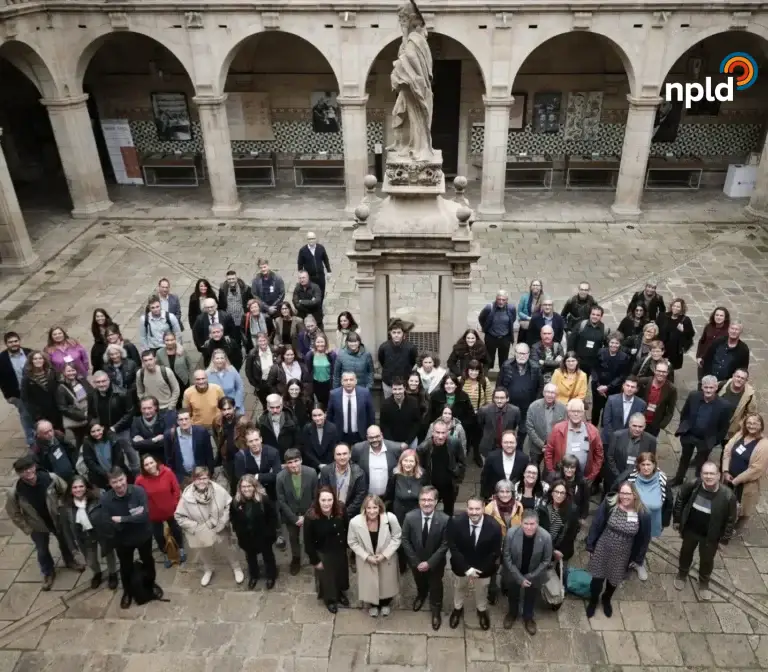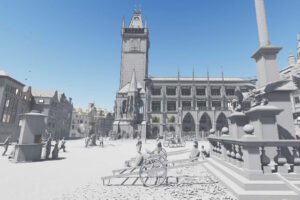3D animation has revolutionized everything from film and television to video games and advertising.
Unlike 2D animation, which uses two-dimensional drawings, 3D animation creates images in a three-dimensional space, giving a sense of depth and realism that transforms the visual experience. Understanding and applying 3D animation opens up a world of unique creative possibilities for companies and artists.
The details and dynamics of motion in 3D animation make it possible to create incredibly realistic characters and scenes.
Advanced modeling technologies and techniques combine to bring ideas and concepts to life in ways that were unimaginable just a few decades ago.
This technique not only enhances visual appearance, but also the ability to tell complex stories in an engaging way.
If you are looking to take your project to the next level with innovative 3D animations, we invite you to contact us at Virtual Arena.
We are experts in 3D animation and design, and we are ready to help you bring your boldest ideas to life.
Would you like to create your own 3d animations?
At Virtual Arena we are experts in 3d design and animation.
How can we help you?
We love challenges!
Fundamentals of 3D Animation
3D animation has transformed how we tell stories and create realistic characters.
Below, we explore its historical evolution and the essential principles that distinguish it from 2D animation.
History of 3D Animation
3D animation began in the 1970s with the use of computer graphics. Movies such as Toy Story marked a milestone as the first fully 3D creation, highlighting the power of the technology at the time.
The evolution of software and computerized techniques has allowed for a more realistic representation of characters and scenery.
Leading companies such as Pixar and DreamWorks have demonstrated that 3D animation is essential to the modern film industry.
In addition, today, it is widely used in video games, advertising and architectural design.
Basic Principles of Animation
The 12 principles of animation developed by Disney remain essential in both 2D and 3D.
These principles help to create more natural movements and emotions in characters. Anticipation and squash & stretch are vital to add realism and clarity.
The use of these principles is so crucial in contemporary animation that some techniques may seem unusual at first glance. unusual at first glance but they proved to be key to a successful outcome.
Mastering them allows artists to ensure that their creations not only move, but also communicate emotions and actions.

2D animation vs. 3D Animation
While 2D animation uses traditional skills, such as hand-drawing, 3D animation combines programming and digital modeling.
3D allows the manipulation of characters in a three-dimensional environment, enhancing the perception of depth and realism in movement.
Despite their differences, both 2D and 3D share the same basic principles.
The challenge of 3D lies in simulating accurate physics and life in characters in a more advanced way than 2D.
For this reason, many artists see 3D animation as an evolution and expansion of the techniques inherited from traditional animation.
3D Animation Software
In the world of 3D animation software, there are multiple options that vary in functionalities and specialties.
We can find free and paid solutions that suit both beginners and experienced professionals.

Blender
Blender is a free and open source 3D animation software, known for its extensive range of features.
It is capable of handling a complete 3D workflow, including modeling, rigging, simulation, rendering and motion tracking.
What makes Blender stand out is its internal rendering engine, Cycles, which delivers high-quality results.
In addition, its active community contributes to its constant improvement through custom add-ons.
Blender is widely used in the industry and offers extensive educational resources, making it accessible to people of all skill levels.
Autodesk Maya
Autodesk Maya is considered one of the most most widely used programs in the film and video game industry.
This animation software stands out for its 3D modeling and advanced animation capabilities.
Maya offers robust tools for simulation and effects, including fluids, particles, cloth and hair, enabling an immersive animation experience.
The software is highly customizable with Python and MEL scripting, offering flexibility to develop custom workflows.
Our experience with Maya highlights its initial complexity, but the superior capabilities it offers are worthwhile for large-scale jobs.
3DS Max
3DS Max is another valuable Autodesk product, more oriented towards 3D modeling than animation per se.
It is mainly used for architectural visualization and game design.
Its integrated tool, MaxScript, allows us to automate tasks and develop custom solutions.
Among its main features, 3DS Max offers polygonal modeling, texturing and a powerful particle system.
It also has support for external rendering engines such as V-Ray, which enhance its production capabilities.
Its ease of use makes it a preferred choice for those seeking efficiency in structural design projects.
Cinema 4D
Cinema 4D is an animation software that specializes in motion graphics and visual effects.
It is highly valued in the film and advertising industry for its intuitive interface and relatively low learning curve.
The ease of integrating this software with other Adobe tools makes it attractive for multidisciplinary projects.
It allows us to create complex animations with a simplified approach and offers extensive libraries of materials and models.
Although it is more expensive than other programs, the premium quality of its tools and ease of use justify the investment, especially in creative studios and advertising agencies.
Houdini
Houdini is distinguished by its procedural approach to creating 3D animations, allowing the generation of complex visual effects.
It is particularly strong in particle simulation and dynamics, making it ideal for creating realistic explosions, smoke and water in animation.
Despite its high learning curve, Houdini is unmatched when it comes to customizing every detail in animation.
Its ability to be integrated into a programming environment enhances our flexibility during creative development.
It proves to be a preferred choice for professionals who need precise control over their visual projects.

3D Model Creation
When creating 3D models, it is essential to understand the processes of modeling, texturing, sculpting, retopology, rigging and skinning.
Each stage plays a crucial role in 3D animation.
Below, we explore each of these steps with a focus on their essential elements.
Modeling and Texturing
In the process of modelingWe establish the basic geometry of the object or character.
We use 3D modeling tools such as Blender to build detailed shapes from simple primitives. Like texturization is the next step where we apply images and patterns to the surface of the model, bringing visual features to life.
Textures can be created using Photoshop or GIMP.
A common practice is UV mapping, where we unroll the 3D surface on a 2D plane to get precise control over texture placement.
This step is crucial to achieve realism in the visual aspects of the models.
Sculpting and Retopology
The sculpted is used to add fine details and achieve a more organic look.
We use specialized software such as ZBrush to carve details in high resolution.
This process allows us to modify the topology of the model and adjust the density of polygons where necessary.
Rheopology is the next step in simplifying the mesh of the sculpted model, ensuring a clean structure that facilitates animation.
During retopology, we reduce the number of polygons without sacrificing visual quality, allowing for smoother animation.
Rigging and Skinning
The rigging involves creating a skeleton within the 3D model that will allow it to move and animate.
We use bones and controllers within the animation application to define how the model should deform during animation.
At the stage of skinningWe adjust how the geometry of the model deforms according to the movements of the skeleton.
We assign weights to the vertices to determine how the bones influence the mesh.
At the end, we check the movement to make sure it is realistic and fluid.
In all these steps, attention to detail and precise control over each element are key to creating efficient and aesthetically pleasing 3D models.

Animation and Rigging
In the exciting world of 3D animation, rigging plays a key role.
This technique allows animators to bring characters and objects to life, ensuring natural and fluid movements.
Through various methods, we address how to animate figures and environments effectively.
Animation Techniques
Animation techniques vary widely depending on the complexity and desired result.
We make use of methods such as keyframe animation, where we define essential poses to which fluid motion is added.
In addition, physics-based animation helps to emulate realistic reactions.
The use of advanced software, such as Autodesk Maya or Blender, facilitates the creation of precise movements.
These programs include tools to interpolate movements and refine details.
Our skill lies in choosing the technique that best suits the project, thus maximizing the visual quality and emotional impact of the animation.
Character Rigging
Character rigging is crucial to bring any 3D model to life.
We create a skeleton structure, made of virtual bones and joints, that allows characters to move naturally.
This process includes assigning controllers to body parts to facilitate animation.
Industry-leading software such as Autodesk Maya and 3ds Max offer efficient tools to set up skeletons and define the range of motion of each joint. The inverse kinematic control (IK) and the direct kinematic control (FK) are techniques used to manage motion flexibility and precision.
Object and Scenery Animation
Animating objects and scenery requires a different approach.
It’s not just about giving the characters movement.
In this case, we optimize the dynamic environment to enhance the visual narrative.
We focus on the weight of objects and the interaction between elements of the environment.
Techniques such as crowd simulation help in complex scenes where there are many actors.
Programs such as Unity and Unreal Engine are key, as they allow the creation of real-time animations.
This is essential for video games and interactive environments, ensuring a smooth and functional integration of all elements.

Advanced Animation Technologies
In the world of 3D animation, advanced technologies are providing us with more accurate and effective tools to create realistic and detailed graphics.
These developments include motion capture, cloth and fluid simulation, as well as virtual and augmented reality applications.
Motion Capture
Motion capture allows us to reproduce human movements with astonishing accuracy in digital environments.
Using sensor suits and high-resolution cameras, we can record even the most subtle facial gestures.
This makes animations more authentic and believable.
In addition, this technology is essential for creating characters in video games and movies by replicating natural, expressive movements.
Advances in motion capture also facilitate a more efficient workflow by reducing the time spent on manual animation.
Simulation of Fabrics and Fluids
Fabric and fluid simulation has transformed how we represent dynamic materials in animation.
It gives us the ability to mimic the actual behavior of fabrics in detail, such as folds or movements in the wind.
Similarly, fluid simulations allow liquids such as water or smoke to interact realistically with environments and characters.
Specialized programs such as Houdini or Maya are widely used for these simulations.
By achieving greater realism, these visual effects enrich the narrative and the overall visual experience we offer.
Virtual Reality and Augmented Reality
Virtual reality (VR) and augmented reality (AR) are revolutionizing our interaction with animated environments.
With VR, users are fully immersed in three-dimensional worlds, while AR superimposes virtual elements on the real world.
These technologies are crucial for designing immersive experiences, especially in the video game and education sector.
Platforms such as Unreal Engine and Unity are frequently employed to develop these environments.
They allow us to explore new forms of narrative and interaction, expanding the creative possibilities in 3D animation.

Rendering and Visual Effects
In the field of 3D animation, rendering and visual effects play a crucial role in bringing digital images to life.
We will explore rendering techniques, the importance of lighting and shading, and the impact of visual effects, including the use of software such as Arnold.
Rendering Techniques
The 3D rendering involves converting three-dimensional data into realistic 2D images.
We use several techniques, such as real-time rendering and ray tracing rendering.
Real-time rendering is essential in video games, where fast and fluid images are required.
On the other hand, the ray tracing provides extremely realistic images by simulating the behavior of light, making it ideal for film and advertising.
The software Arnold is popular in the film industry due to his ability to handle complex scenes with high quality.
Lighting and Shading
Lighting and shading are fundamental to give depth and realism to a scene.
In these processes, we adjust the position and type of light to highlight specific actors within a scene.
Techniques such as hard and soft shading affect the visual atmosphere.
The rendering effective depends on understanding how light interacts with different surfaces.
We use shadows to add details that change the visual perception of textures and volumes.
The correct application of these techniques improves the visual quality of any animated project.
Visual Effects (VFX)
The visual effects (VFX) are crucial for integrating elements that were not filmed directly.
They enhance scenes using digital techniques that combine live action with computer-generated images.
In action and science fiction films, such as superhero movies, we recreate explosions and fantastic creatures with special effects digital.
In addition, we use programs that allow us to adjust shadows, lighting and textures to ensure consistency throughout the scene.
Integrating VFX into our projects enriches the visual storytelling and offers more immersive experiences for the viewer.

3D Animation in Video Games
In the world of video games, 3D animation has become a central technique for creating compelling visual experiences.
This technique allows the design of realistic characters and environments, enriching gameplay.
Here we will see how this technology is developed, and the impact of tools such as Unity and Unreal Engine on the interactivity and performance of games.
Game Development
3D animation is crucial in video game development.
It allows developers to create three-dimensional characters and immersive worlds.
These characters and environments are first modeled, then animated to reproduce natural movements and complex action scenes.
Modern games rely heavily on 3D animation to deliver immersive visual experiences.
In addition, animation techniques are used to enhance the game’s narrative, conveying emotions through facial expressions and body language.
This adds an extra dimension to the development, bringing to life stories and characters that capture the player’s attention.
Unity and Unreal Engine
Unity and Unreal Engine are two of the most popular platforms used to create 3D animations in video games.
Unity, known for its flexibility and ease of use, allows creating games on multiple platforms.
Its extensive library of resources facilitates development and animation, without requiring advanced programming skills.
On the other hand, Unreal Engine is noted for its ability to render advanced graphics, delivering exceptional visual quality in video games.
With its robust physics engine, Unreal Engine is ideal for games that require detailed and realistic visual effects.
The choice between Unity and Unreal Engine often depends on the type of game we are developing.
Interactivity and Performance
Interactivity is fundamental to video games, and 3D animation plays a key role in how the game’s response to the player’s actions is perceived.
Smooth movements and accurate reactions enhance the player’s experience.
Well-executed animations can also reduce perceived latency, making actions seem more immediate.
Technical performance is also crucial.
3D animations need optimization so as not to overload system resources.
This is especially important on mobile devices, where hardware resources are limited.
Efficient use of memory and GPU ensures that games run smoothly, maintaining an immersive gaming experience without sacrificing visual quality.

3D Animation Industry and Business
3D animation is a growing industry with significant opportunities in different markets and roles.
It involves developers and artists in the creation of dynamic content.
We address the size of the market, the most in-demand professional roles and the development of software and APIs.
3D Animation Market
The 3D animation market has seen remarkable growth in recent years.
Thanks to the growing demand in the entertainment industry, 3D animation is becoming more and more integrated into various platforms. 3D modeling is a key area, accounting for 30.4% of the market in 2023 according to the technology analysis.
This growth is not only driven by entertainment, but also by sectors such as education and advertising.
Companies are looking to use 3D animation to create more engaging and educational content.
Investing in advanced tools and skilled talent is crucial to stay relevant.
Professional Roles of 3D Animators
In the professional field, the roles for 3D animators are varied and specialized.
They range from modelers to visual effects artists.
Cada uno desempeña un papel crucial en el desarrollo de proyectos de animación.
Para aquellos interesados en entrar en el campo, es fundamental entender que el trabajo puede ser competitivo.
Animation studios are looking for professionals with skills in advanced software, texture handling and special effects.
In addition, collaboration is vital, as we often work in multidisciplinary teams.
This not only improves the quality of the final product, but also fosters creativity and innovation.
APIs and Software Development
The APIs play a key role in the development of 3D animation software.
They facilitate the integration of different tools, allowing developers to create more complex and efficient solutions.
APIs enable connectivity and allow different applications to work together seamlessly.
Companies are investing in software development that can optimize animation creation processes.
Advanced modeling and rendering tools are integrated through APIs, boosting functionality and efficiency.
Ongoing collaboration between developers and artists is key to constant innovation in this evolving industry.

What are the advantages of 3D animation over 2D animation?
3D animation allows you to create a sense of depth and realism that is difficult to achieve with 2D animation.
Through modeling in a three-dimensional space, characters and scenery can be manipulated to simulate more natural and complex movements.
In addition, it facilitates the simulation of advanced physics and visual effects, offering a more immersive visual experience.
Which 3D animation software is best suited for beginners?
For beginners, Blender is an excellent choice.
It is free, open source and has a wide range of features that cover the entire 3D animation workflow, from modeling to rendering.
In addition, it has an active community and many educational resources, making it easy to learn and continuously improve.
What are the current trends in 3D animation?
Current trends in 3D animation include the use of artificial intelligence and machine learning to improve the creation of more realistic and efficient animations.
Augmented reality (AR) and virtual reality (VR) are integrating 3D animation to create more interactive experiences.
In addition, real-time animation is becoming more popular, especially in video games and live broadcasts, thanks to the evolution of graphics engines such as Unreal Engine.
How has 3D animation evolved in the film industry?
3D animation has transformed the film industry since the 1970s.
Films such as Toy Story marked a milestone by being fully animated in 3D.
Since then, the evolution of software and techniques has enabled the creation of increasingly realistic characters and worlds.
Today, 3D animation is essential in the production of live-action, animated films and in the creation of visual effects.
How are the 12 principles of 3D animation applied?
The 12 principles of animation, developed by Disney, are fundamental to creating natural and expressive movements in both 2D and 3D animation.
In 3D animation, these principles, such as anticipation, squash & stretch and secondary action, are applied through the digital manipulation of models and their rigging.
For example, anticipation is used to prepare the viewer for an action, adding realism and believability to character movements.
Share note:
Recent articles
Contact with experts
Looking to create a 3d animation project? At Virtual Arena we are professionals in creating digital experiences.
Do you have a project in mind?






